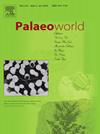通过足迹揭示大型鸟脚类动物的多样性和鉴别力(西班牙,下白垩统):表型关联方法
IF 1.7
3区 地球科学
Q2 PALEONTOLOGY
引用次数: 0
摘要
在伊比利亚半岛巴里米亚时期形成的冲积-海岸沉积系统中,经常出现大型兽脚类动物。本文分析了 Maestrazgo 盆地(西班牙伊比利亚盆地)西南部巴雷姆时期 Camarillas 地层中大型鸟脚类动物的几枚脚印。根据一些形态特征,如指骨长度、"脚跟 "垫印的宽度和第三指骨近端部分的宽度,对三个不同大小级别的两种形态的足迹进行了区分。这些石膏被归类为 Caririchnium isp。形态 1 代表小到大的足迹,而形态 2 代表中等大小的足迹。形态类型 1 的足迹之间的形态差异可能是一种个体发育差异。相反,形态 1 和形态 2 之间的差异不能仅用形态外的原因来解释,因此可能代表了不同的履带制作者,特别是考虑到巴里米亚节肢动物的多样性。为了推断可能的履带制作者,我们对伊比利亚地区几种保存完好的铸模和已鉴定的巴里米亚兽脚类足部进行了修正的表型相关性分析。形态 1 与大型伊瓜齿兽的足部骨骼结构相吻合,包括与伊瓜齿兽周足完全吻合的小尺寸足迹。形态 2 与中型曼特力龙的脚骨骼结构更为吻合。在欧洲下白垩世的其他地区也可以发现类似的两种形态,因此可以初步认为它们是由欧洲早白垩世典型的两种大小的styracosternans类群产生的。因此,通过手足学分析,可以对直接记录中已知的多样性进行区分。此外,古生态学分析表明,两种体型的styracosternans之间存在空间生态位分区,因为这些恐龙的大体型足迹和骨骼在此类沉积物中最为常见。本文章由计算机程序翻译,如有差异,请以英文原文为准。
Diversity and discrimination of large ornithopods revealed through their tracks (Lower Cretaceous, Spain): A phenetic correlation approach
Large ornithopods were frequent in the alluvial-to-coastal sedimentary systems developed during the Barremian in the Iberian Peninsula. Here, several pes track casts of large ornithopods from the Barremian Camarillas Formation of the southwestern sector of the Maestrazgo Basin (Iberian Basin, Spain) are analyzed. Two morphotypes of tracks from three different size classes are differentiated based on some morphological features, such as length of digits, the width of the “heel” pad impression, and width of the proximal part of digit III. These casts are assigned to Caririchnium isp. Morphotype 1 is represented by small to large-sized tracks, whereas Morphotype 2 by medium-sized tracks. Morphological variation seen among tracks of Morphotype 1 is interpreted to be possibly an ontogenetic variation. On the contrary, the differences seen between Morphotype 1 and 2 cannot be explained only by extramorphological causes, so might represent different trackmakers, especially when taking into account the considerable Barremian ornithopod diversity. A modified phenetic correlation is carried out between several well-preserved casts and the identified feet of Barremian ornithopods from Iberia, in order to infer the putative trackmakers. Morphotype 1 fits with the foot skeletal structure of the large styracosternan Iguanodon, including small-sized tracks that are perfectly accommodated to that of perinates of I. galvensis. Morphotype 2 matches better to the pes skeletal structure of the medium-sized Mantellisaurus. Similar two morphotypes can be also identified in other areas of the Lower Cretaceous of Europe, so, they could be tentatively produced by the two sized groups of styracosternans typical in the Early Cretaceous of Europe. Therefore, the ichnological analysis may allow differentiation of the diversity known through the direct record. In addition, the paleoecological analysis indicates a spatial niche partitioning between two size groups of styracosternans, because large-sized tracks and bones of these dinosaurs are the most common in such sediments.
求助全文
通过发布文献求助,成功后即可免费获取论文全文。
去求助
来源期刊

Palaeoworld
PALEONTOLOGY-
CiteScore
4.00
自引率
5.90%
发文量
95
期刊介绍:
Palaeoworld is a peer-reviewed quarterly journal dedicated to the study of past life and its environment. We encourage submission of original manuscripts on all aspects of palaeontology and stratigraphy, comparisons of regional and global data in time and space, and results generated by interdisciplinary investigations in related fields. Some issues will be devoted entirely to a special theme whereas others will be composed of contributed articles. Palaeoworld is dedicated to serving a broad spectrum of geoscientists and palaeobiologists as well as serving as a resource for students in fields as diverse as palaeobiology, evolutionary biology, taxonomy and phylogeny, geobiology, historical geology, and palaeoenvironment.
Palaeoworld publishes original articles in the following areas:
•Phylogeny and taxonomic studies of all fossil groups
•Biostratigraphy, chemostratigraphy, chronostratigraphy
•Palaeoecology, palaeoenvironment and global changes throughout Earth history
•Tempo and mode of biological evolution
•Biological events in Earth history (e.g., extinctions, radiations)
•Ecosystem evolution
•Geobiology and molecular palaeobiology
•Palaeontological and stratigraphic methods
•Interdisciplinary studies focusing on fossils and strata
 求助内容:
求助内容: 应助结果提醒方式:
应助结果提醒方式:


